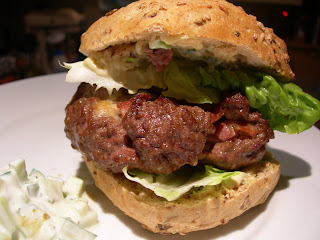Googling Rachael Ray suggests that the American public are pretty divided in their opinion of her. I have to confess that when I shortlisted her I had no idea of her public persona. I was therefore somewhat taken aback when Stuart produced Guy Food. The blurb reads as follows: Rachael says, 'Guys who cook are hot! Step into the kitchen with these Top 30 meals with guy appeal. This collection of greatest hits features simple recipes with big flavors, perfect for date nights, game nights, or just hangin' out'. Throughout, Rachael exhorts her projected male reader to be 'hot' in the kitchen, to find his soulmate (or just a date) through simple but tasty manfood that can appeal to girls as well. It is indescribably tacky. The book even looks tacky; it's an annoying shape and size. Still, far be it from me to look a gift horse in the mouth (actually, I imagine I would look a gift horse in the mouth. I'd never look a gift cookbook in the mouth though) and I was entertained as I read through Rachael's recipes. I also tried one -the inside-out bacon cheeseburger with green onion mayo. It is a basic burger but inverted; the cheese and (cooked) bacon are inserted inside the burger, which gives it an interesting taste and texture.

OK, so the book is unbelievably tacky but the burger was delicious. Actually, all the recipes look kind of tempting, once you've got past their annoying presentation. It is the kind of food people actually want to cook and eat; nothing too tricky, and a good mixture of recipes (spicy food, lots of different burgers, pasta, meat dishes). I'm still not sure about the whole Guy Food thing - it seems to be billing its recipes as both perfect to cook for a romantic date with a dream woman and as the sort of food that might go down well on a lads' night out. I'm not sure that these two categories are necessarily similar and I can't see why this is 'guy' food in particular (apart from the relatively high content of meat recipes, which food writers seem to associate with men). But if the concept bombs, the food doesn't. I can't say I'll be rushing to order more of Rachael's impressive list of publications (unless anyone out there thinks I'm missing something), so
I have no idea if this book is representative of Rachael's other books or if this one is a one-off... Still, one thing it does teach me is not to judge a recipe by the cookbook cover, or I'd never have tried this simple but tasty inside-out bacon cheeseburger. Oh dear. Even the name of the recipe is a bit, ahem, tacky.
In other news, we're going out with friends for dinner tonight, to a nice dining pub. I am salivating already. Oh, and it's got cold again, so it's a good thing that I didn't end up seduced by the sandals the other day.








